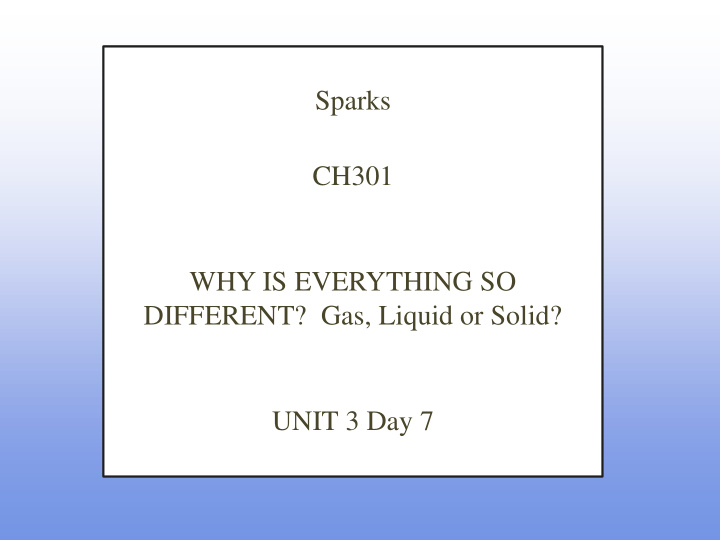



Sparks CH301 WHY IS EVERYTHING SO DIFFERENT? Gas, Liquid or Solid? UNIT 3 Day 7
What are we going to do today? Discuss types of intermolecular forces. Compare intermolecular forces for different molecules. Discuss the effect of these forces on properties of substances.
INTERMOLECULAR FORCES: fact check Water and Ethanol attracted to charged rod. Hexane and Carbon Tetrachloride NOT attracted to charged rod. Explanation: presence of dipole moment How is it possible for Hexane and Carbon Tetrachloride to exist as liquids?
INTERMOLECULAR FORCES: fact check How is it possible for Hexane and Carbon Tetrachloride to exist as liquids? THERE MUST BE AN ELECTROSTATIC ATTRACTION! EXPLANTION: INDUCED DIPOLE – INDUCED DIPOLE
INTERMOLECULAR FORCES: Induced dipole – Induced dipole Exist in all condensed substances Caused by induced dipoles, which come and go in nonpolar molecules and atoms E 1 r 6
Look at the table on p. 73 of your course packet. 1. Comment on the correlation of molecular weight and boiling point for the first four substances (methane – octane). • What do you think this says about the strength of the induced dipole-induced dipole interactions as MW increases? 2. Now look at the last value on the table – carbon tetrachloride. Does this fit with your MW:interaction strength correlation? • Suggest another factor you think might be important in determining strength of interactions.
INTERMOLECULAR FORCES: Induced dipole – Induced dipole Strength depends on polarizability
INTERMOLECULAR FORCES: fact check STRENGTH DEPENDENT ON POLARIZABILITY CCl 4, (154 g/mol) boiling point = 77 ° C C 8 H 18 (114 g/mol) boiling point = 126 ° C Strength also depends on SHAPE of molecule
Hard question….. Why can’t the charged glass rod induce a dipole? Lots of common examples: oils versus fats plastic wrap vs milk jugs FAVORITE ANALOGY - VELCRO
INTERMOLECULAR FORCES Induced dipole – induced dipole This type of intermolecular force goes by several different names: Induced dipole – Induced dipole Dispersion Forces London Forces Van der Waal’s Forces
Answer question #3 on page 74 using data from your chart. Why do you think this is true?
Hydrogen bonding* Subset of dipole-dipole interactions Molecules with H attached to F, O, or N *“Hydrogen Bond” a misnomer – implies a chemical bond; just a very strong dipole-dipole interaction.
Hydrogen bonding* Strength depends on distance and dipole moment.
Quiz: CLICKER QUESTION Draw dot structures for ethyl alcohol, CH 3 CH 2 OH and consider if hydrogen bonding would occur in a sample of this substance. A. Yes, this molecule would exhibit hydrogen bonding. B. No, this molecule would not exhibit hydrogen bonding.
Quiz: CLICKER QUESTION Would hydrogen bonding occur in a sample of CH 3 CH 2 OCH 2 CH 3 ? A.Yes. B.No.
WHAT HAVE WE LEARNED TODAY? PHYSICAL PROPERTIES DEPEND ON COMPOSITION & SHAPE OF COMPOUND CLASSIFY INTERMOLECULAR FORCES ION-ION vs. DIPOLE-DIPOLE vs. INDUCED DIPOLE – INDUCED DIPOLE PREDICT WHAT TYPE OF IMFs EXIST FOR A PARTICULAR COMPOUND
Learning Outcomes Define the three major types of intermolecular forces (IMF) discussed in class: • dipole-dipole, • H-bonding, and • dispersion (London, van der Waals, • induced dipole-induced dipole) Explain how molecular size and shape affect the magnitude of the dispersion forces
Recommend
More recommend